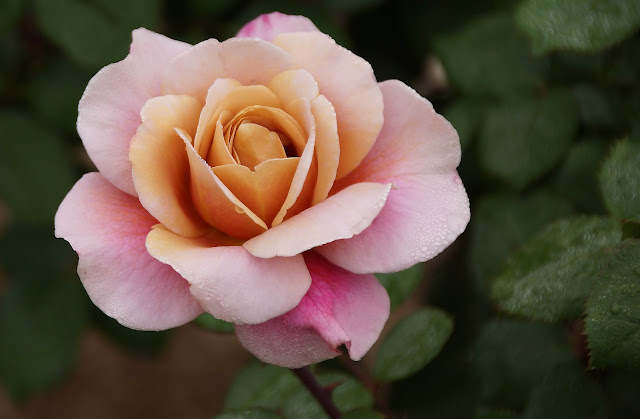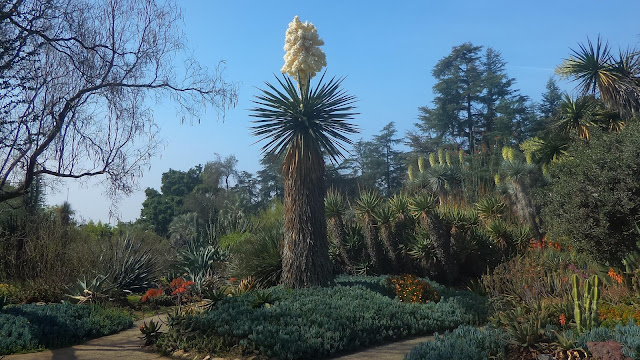What's blooming?
Mammillaria species
Wisteria
Tree Peony!
Camellia
Uhh...erm...Primula malacoides (Thanks for the ID, Forest!)
Polygonatum odoratum
Camellia Yamato-Nishiki, "higo style" flower
Azaleas
Uhh...this was a popular ground cover in Southern California for a while, back when water was more plentiful. Persicaria capitata, thanks to Close To Home for the ID.
New growth on groomed pines in the Japanese-style garden
Cherry blossom
Azaleas
Spring bulbs in the rose garden
'Distant Drums'
'Iceberg' buds
Clivia in the subtropical garden
Aloes in the Desert Garden. The mass of orange/yellow is Aloe camperi 'Cornuta'.
Golden barrel cactus in a mass of Crassula bloom stems
The shephard's crook shapes of Echeveria agavoides
Aloe africana
A wow!
Aloe africana again, up close
Aloe...uh...sinkatana-ish
Aloe speciosa
Achmea recurvata (Thank you Roger for the ID!)
Erythrina acanthocarpa
Oxalis gigantea. Yes, that's a six foot tall Oxalis.
Agaves with an unreal plume of Yucca flowers in the background.
Wow. More Yucca flowers in the background
Some sort of ice-plant type thingy. Drosanthemum speciosum 'Pele'. (Thanks again for the ID, Jane!)
Every time we go the entrance garden has changed slightly
There were a lot of small succulents in this spot last time. Now there are Layia platyglossa and Eschscholzia californica, California native wildflowers
Hesperaloe parviflora 'Brakelights'
Kniphofia with Echium candicans in the background
Echium candicans with Eucalyptus 'Moon Lagoon' foreground right
And that Yucca one more time
What a great way to celebrate the Vernal Equinox!








































Agreed and a happy spring to you, too.
ReplyDeletePersicaria capitata
Drosanthemum speciosum
Awesome Jane thanks for the IDs I will update!
DeleteShould be Drosanthemum speciosum 'Pele' to distinguish it from the purple one
ReplyDeletePrimula candelabra-type (the pink flower)
Great! Thanks again!
DeleteSo much lovely, but I especially liked the Erythrina acanthocarpa (wow!) and the yucca bloom -- looks like a volcanic ash cloud rising in the distance! Wow!
ReplyDeleteVolcanic ash cloud--that's it! You got it exactly. Coming around a curve in the pathway and seeing that was quite a surprise.
DeleteHuntington, so very, very beautiful and that at this very, very moment. Looking forward to lots of sun here.....
ReplyDeleteSun for you, great! Everything will start growing and blooming...enjoy!
DeleteLovely, I'm especially enthralled with the Erythrina acanthocarpa...wow!
ReplyDeleteOrange and chartreuse, together in one flower! :)
DeleteTerrific photos (as usual)! In addition to salivating over the tree peony, I was astounded by the mass of Echeveria bloom stalks among the barrel cactus - what a show they will make when they bloom!
ReplyDeleteLots of happy, happy plants. It was a joy.
DeleteSigh...
ReplyDeleteSpring: coming to your neighborhood soon!
DeleteYou had me drooling all the way until the barrel cactus photo, most of the plants before would have been happy in my garden. Lots of lovely plants for....ehh, not for my climate unfortunately. But I can grow Yucca and get it to flower, just need a lot of space as they get huge over here too. Thanks for the stroll, lovely garden!
ReplyDeleteWe started our stroll in the Huntington's Chinese-style garden, and went next to the adjacent Japanese-style area, which is at its best in late winter/early spring. Both of these have plants more likely to survive in your climate. Happy I included something drool-worthy for you. The tree peony which is rare and somewhat difficult here was an amazement and a treat to see.
DeleteYucca are incredibly tough, as are, surprisingly, Camellias. The oldest Camellia at the Huntington is well over 100 years old and is still thriving.
That wouldn't be something as common as wild form Primula malacoides would it?
ReplyDeleteYes indeedy. Thanks for the ID!
DeleteI'd love to see an 'entrance garden through the seasons' feature (hint, hint!)
ReplyDeleteDo you know what the warm bricky-red plant is in the first rill picture from the entrance garden?
The warm bricky-red is and Anigozanthos (Kangaroo Paws) cultivar; a royal pain of a plant to keep alive--I wonder if they are replacing them regularly.
DeleteI have been thinking about going back and looking at all the different plantings of that space I have pictures of, to see what has changed, progressed, etc. Good idea. I'll see what I have...
I'm glad you said that about the kangaroo paws. Nurseries always say how easy they are; I find them incredible difficult to keep alive. I've killed more kangaroo paws than anything else, I think!
DeleteSo nice! I've been in Morro Bay all week, and I've lost count of the flowering Leucospermums I've seen. I'm so jealous how easy they seem to be in this cool coastal climate.
ReplyDeleteThat central coast climate is really something. I saw an Aeonium there the size of an Agave. Seeing your reports makes me want to get back there.
DeleteThe Leucospermums are grown for the cut-flower industry in interior San Diego county, where the summers are fierce--so they can take heat. I think what they need is sharp sharp drainage, gritty soil.